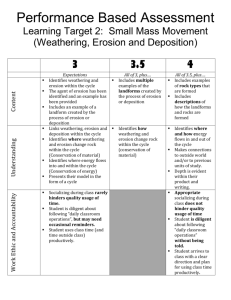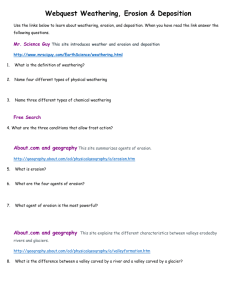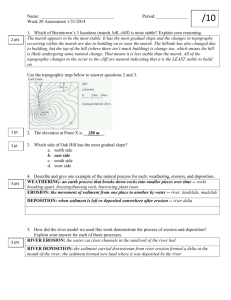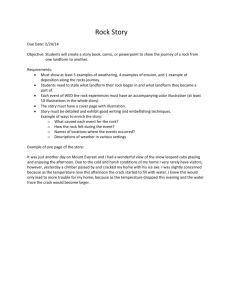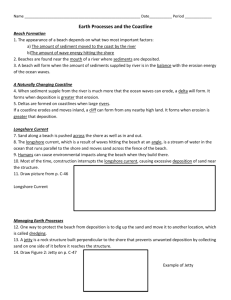Unit C- Erosion and Deposition Study Guide/Review 1. How do
advertisement
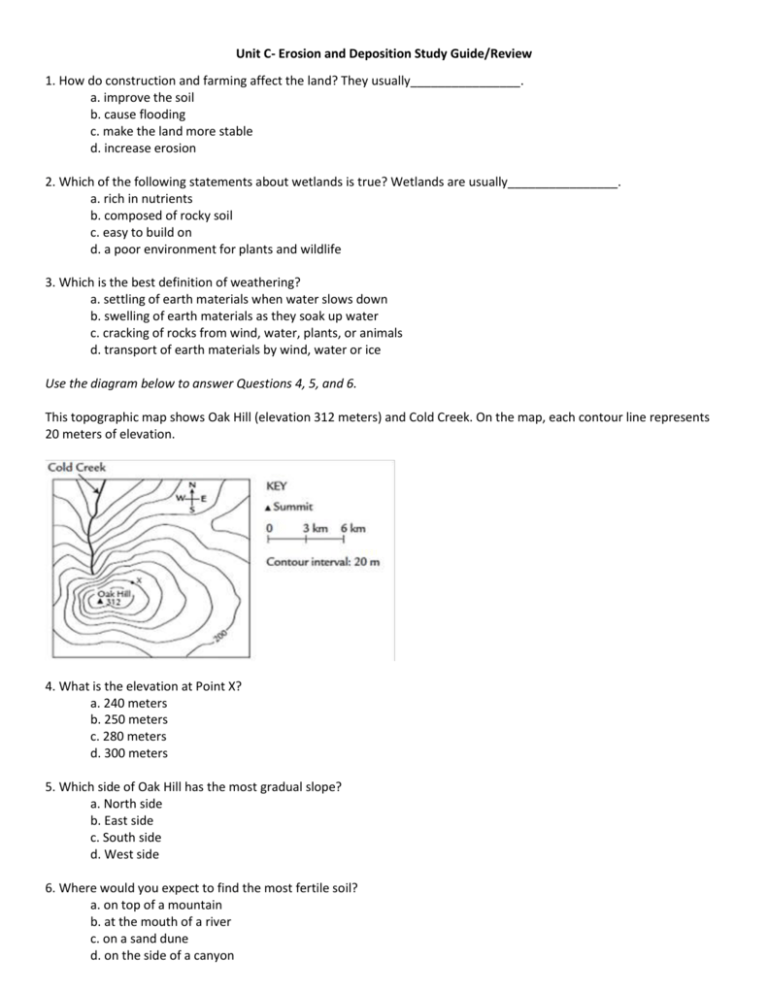
Unit C- Erosion and Deposition Study Guide/Review 1. How do construction and farming affect the land? They usually________________. a. improve the soil b. cause flooding c. make the land more stable d. increase erosion 2. Which of the following statements about wetlands is true? Wetlands are usually________________. a. rich in nutrients b. composed of rocky soil c. easy to build on d. a poor environment for plants and wildlife 3. Which is the best definition of weathering? a. settling of earth materials when water slows down b. swelling of earth materials as they soak up water c. cracking of rocks from wind, water, plants, or animals d. transport of earth materials by wind, water or ice Use the diagram below to answer Questions 4, 5, and 6. This topographic map shows Oak Hill (elevation 312 meters) and Cold Creek. On the map, each contour line represents 20 meters of elevation. 4. What is the elevation at Point X? a. 240 meters b. 250 meters c. 280 meters d. 300 meters 5. Which side of Oak Hill has the most gradual slope? a. North side b. East side c. South side d. West side 6. Where would you expect to find the most fertile soil? a. on top of a mountain b. at the mouth of a river c. on a sand dune d. on the side of a canyon 7. Which of the following earth processes typically follows erosion? a. precipitation b. concentration c. deposition d. evolution 8. Look at the following data for rainfall for a five-year period Year Rainfall (cm) 2000 45 2001 62 2002 50 2003 58 2004 25 a. What is the mean rainfall for the time period? _____________________________ b. What is the median rainfall for the time period? _____________________________ c. What is the mode rainfall for the time period? _____________________________ 9. I will ask you to draw a bar graph similar to the rainfall for 2000–2004 data table from question 8. Place“Year” on the horizontal axis and“Rainfall (cm)” on the vertical axis. 10. Which of the following is a constructive force (build up) that changes the surface of the Earth over time? a. Deposition b. Earthquakes c. Tidal waves d. Weathering 11. When the ocean waves hit shore, the land is affected. If the shore is rock, which of the following would you expect to see? A. Erosion B. Deposition C. Earthquake D. Dunes 13. The process of the ocean waves breaking down the seashore or beach is called— A. erosion B. deposition C. weathering D. sedimentation 14. The movement of sand along the beach and the erosion of rock on the shore are the direct result of – A. environmental pollution B. river flooding C. glacial deposition D. wave action 15. What is one way that ocean currents affect the land? Ocean currents— A. create mountains and valleys on the land B. cause weathering, deposition, and erosion C. cause temperatures to be lower on land D. cause ships to roll in high waves The diagram below shows a river flowing through a valley. 16. Which of the following processes most likely caused the river valley to form? A Evaporation B Erosion C Deposition D Condensation 17. What are Earth’s surface features are called? A Rocks B Continents C Landforms D Earthquakes 18. Names and dates on cemetery tombstones are often worn away by the constant exposure to wind, rain and frost. This process is known as: A. Erosion B. Frost action C. Volcanic action D. Weathering. 19. What was the name of the town in this unit where they wanted to construct the new building? a. b. c. d. Chicago Florida Boomtown Illinois 20. Name three problems that the city of New Orleans faces as a result of its location on the banks of the Mississippi River? Remember: New Orleans is built on a marsh. 21. Why is weathering important to the process of erosion? 22. Why does erosion always lead to deposition? Explain and provide an example.

